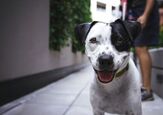What Are Symptoms of Anxiety in Dogs?

Just like humans, dogs can experience stress and anxiety due to various factors - separation from their owners, loud noises, unfamiliar environments, or even past trauma. While occasional nervousness is normal, chronic anxiety can lead to behavioral and health issues. Recognizing the signs early allows you to take steps to ease your dog's distress and improve their overall well-being.
Common Signs of Anxiety in Dogs
Dogs show anxiety in different ways, ranging from subtle body language changes to more obvious behavioral problems. Here are some key symptoms to watch for:
- Excessive Barking or Whining – If your dog frequently whines, howls, or barks, especially when left alone, it could be a sign of separation anxiety.
- Destructive Behavior – Chewing furniture, scratching at doors, or destroying household items often stems from stress or an attempt to escape. Redirecting their attention to chew toys or crate training can help reduce these behaviors.
- Pacing and Restlessness – An anxious dog may walk back and forth or seem unable to settle, particularly in response to loud noises like thunderstorms or fireworks. In these cases, calming aids such as a Thundershirt can provide comfort.
- Trembling or Shaking – Some dogs, especially smaller breeds, may tremble when feeling stressed or fearful, though this can occur in any breed.
- Excessive Licking or Chewing – Some dogs cope with anxiety by licking or chewing their paws, fur, or skin, which can lead to irritation or even wounds requiring veterinary attention.
- Loss of Appetite – Some anxious dogs refuse food due to stress, while others may overeat as a coping mechanism. If appetite changes persist, a vet visit is recommended.
- Hiding or Seeking Isolation – An anxious dog may retreat under furniture, avoid eye contact, or seek out a secluded spot, especially when faced with unfamiliar people or situations. Ensuring a secure environment and using a leash in unfamiliar places can help prevent a scared dog from wandering off.
How to Help an Anxious Dog
If you notice any of these signs, it’s essential to take action to address the root cause and provide comfort. Here are a few effective ways to reduce anxiety in your dog:
- Regular Exercise & Play – Physical activity and interactive toys can help release pent-up energy and reduce stress.
- Create a Safe Space – A quiet, cozy area where your dog can retreat when feeling overwhelmed helps them feel secure.
- Consistent Routine – Predictability in daily routines can help dogs feel more at ease.
- Desensitization Training – Gradually exposing your dog to anxiety triggers in a controlled way can help them build confidence over time.
- Consult a Veterinarian – If anxiety persists, your vet may recommend behavioral therapy or medication to help manage stress.
With patience and the right approach, anxiety can be managed, and your dog can regain their confidence and happiness. A calm, reassured pup means a happy home for both of you!

A proud mama to seven dogs and ten cats, Angela spends her days writing for her fellow pet parents and pampering her furballs, all of whom are rescues. When she's not gushing over her adorable cats or playing with her dogs, she can be found curled up with a good fantasy book.
More by Angela Vuckovic

























